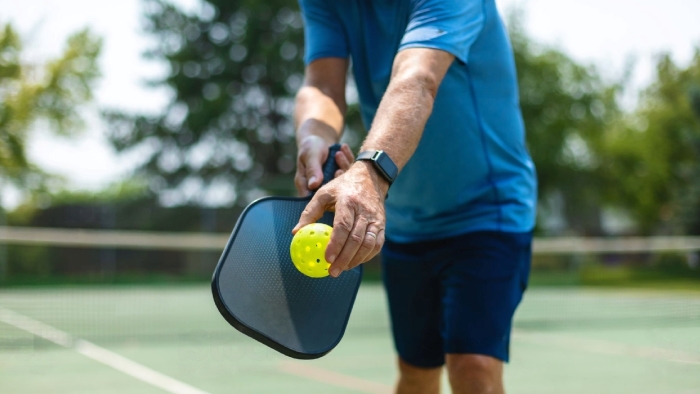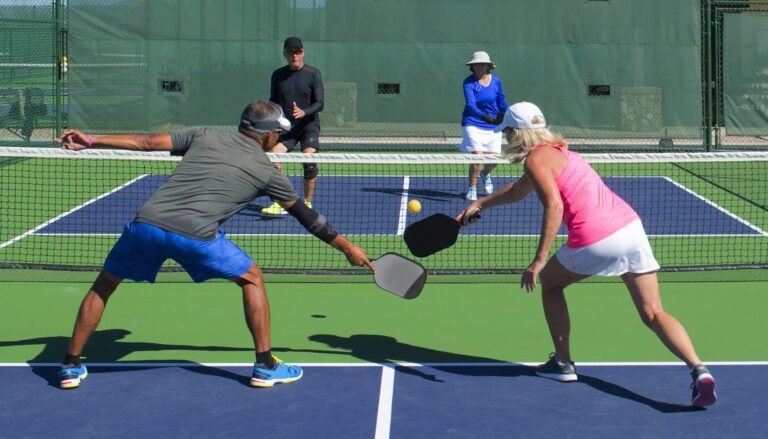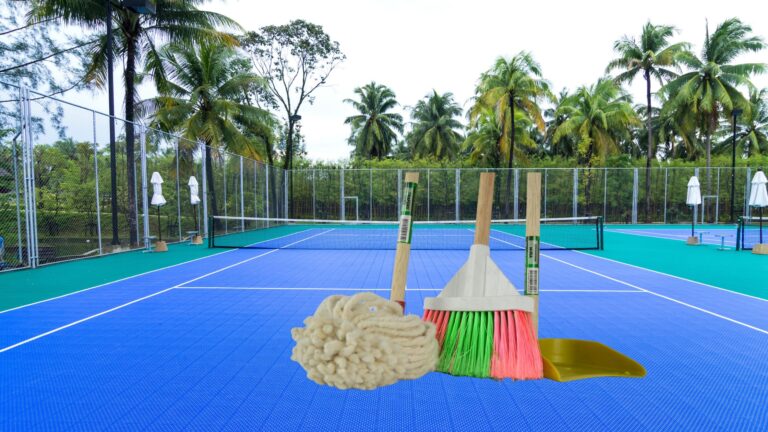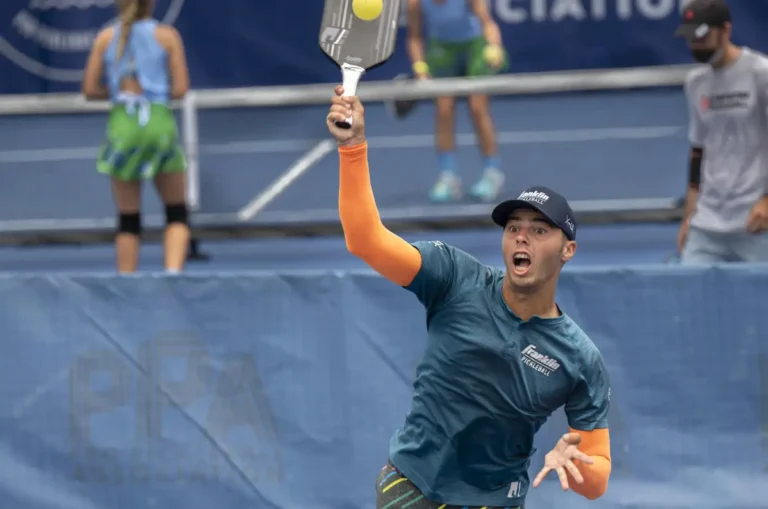5 Essential Techniques for Effective Pickleball Blocking
Pickleball blocking is a crucial skill to master for any player aiming to enhance their defensive game. This guide introduces 5 essential techniques that will help you effectively neutralize powerful shots and maintain control on the court. From adopting the correct stance to adjusting your paddle angle, these strategies, derived from seasoned players’ insights, ensure you’re ready to tackle any aggressive play with confidence
Key Takeaways:
To excel in pickleball blocking, follow these 5 essential techniques:
- Adopt a Low Stance: Stay low with knees bent to react swiftly to shots, enhancing your ability to block effectively (The Pickler).
- Prepare Your Paddle: Keep your paddle in front of your body, ready to intercept the ball. This position helps you control and reset the game by neutralizing aggressive shots (The Pickler, PrimeTime Pickleball).
- Adjust Paddle Angle: Tilt your paddle based on the shot’s angle. For downward shots, angle it slightly down; keep it neutral for flatter shots to create backspin and control (The Pickler).
- Maintain a Soft Grip: Use a relaxed grip on the paddle, around a 4 out of 10 in pressure, which allows for greater touch and control when blocking (The Pickler, PrimeTime Pickleball).
- Use No Swing Blocking: Instead of swinging at the ball, let it come to you and use the opponent’s pace to your advantage. This helps in reducing mis-hits and controlling the return effectively (Pickleball Superstore, PrimeTime Pickleball).
By integrating these techniques into your play, you’ll enhance your defensive capabilities and maintain better control during games, making your blocking both effective and strategic.
Introduction to Pickleball Blocking
Pickleball is a game that demands:
- Precision
- Agility
- Strategy
While scoring points with well-placed shots is exhilarating, the true test of a player’s mettle lies in their defensive prowess, specifically their ability to block shots effectively. Mastering the art of blocking can elevate your game, transforming you from a mere participant into a formidable force on the pickleball battlefield.
Imagine this scenario:
You’re locked in an intense pickleball skirmish, trading volleys with your opponents like a heated verbal exchange. The air crackles with intensity as you anticipate their next move. Suddenly, a blistering shot comes hurtling towards you, leaving you mere milliseconds to react.
In that pivotal moment, your blocking skills could mean the difference between:
- A triumphant counter-attack
- A soul-crushing defeat
Fret not, dear picklers! We’ve got your back (or should we say, your paddle?). Today, we’ll unveil five essential techniques that will transform you into a blocking maestro, capable of deflecting even the fiercest of shots with the grace of a matador and the poise of a seasoned warrior.
Technique 1: Adopting the Right Stance
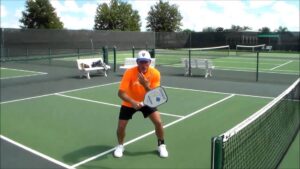
The foundation of effective blocking lies in your stance. Think of it as the sturdy base upon which your defensive prowess is built. A low, athletic stance is the key that unlocks your full blocking potential, like a master unlocking the secrets of an ancient martial art.
Envision a sprinter in the starting blocks, coiled and ready to explode into action at the slightest provocation. That’s the stance you should strive for when blocking shots in pickleball:
- Bend those knees
- Distribute your weight evenly on the balls of your feet
- Keep your center of gravity low
This stance will not only enhance your mobility but also ensure that you’re ready to react swiftly to any incoming shots, like a coiled spring waiting to release its energy at the perfect moment.
Key Stance Elements:
| Element | Description |
|---|---|
| Knees | Bent |
| Weight Distribution | Evenly on balls of feet |
| Center of Gravity | Low |
| Body Position | Athletic, ready to explode |
With a solid foundation in place, you’ll be prepared to meet any challenge the court throws your way, whether it’s a searing groundstroke or a devilish drop shot.
Technique 2: Paddle Preparation and Positioning
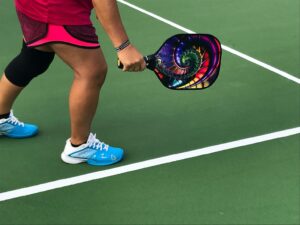
Your paddle is your trusty sidekick in the battle against errant shots, your sword and shield in the pickleball arena. Just as a knight wouldn’t venture into battle without their trusty weapons, you shouldn’t step onto the pickleball court without proper paddle positioning.
Keep your paddle in front of your body, with your elbow bent and ready to intercept any shots that come your way. This position:
- Puts you in a defensive stance
- Allows you to control and reset the game
- Neutralizes aggressive shots with a soft return into the non-volley zone
Ideal Paddle Position:
| Body Part | Position |
|---|---|
| Paddle | In front of body |
| Elbow | Bent |
| Contact Point | 1-2 feet in front of body |
Pro Tip: Envision your paddle as a shield, ready to deflect any incoming projectiles (or in this case, pickleball shots). By keeping it in front of you, you’ll be better equipped to protect your territory and maintain control of the game, like a seasoned warrior defending their domain.
Technique 3: Adjusting Your Paddle Angle
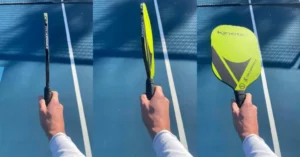
Just as a skilled archer adjusts their bow based on wind conditions and distance, you must adapt your paddle angle to the trajectory of the incoming shot. This subtle adjustment can mean the difference between a controlled return and a mishit that sends the ball sailing into the next county (or, in pickleball terms, the parking lot).
For downward-trajectory shots:
- Tilt your paddle slightly downward
- Match the angle of the incoming ball
- Redirect shot with minimal effort while maintaining control
For flatter shots:
- Keep paddle angle relatively neutral
- Or tilt it slightly upwards
- This creates backspin for a controlled drop over the net
Paddle Angle Adjustment Guide:
| Shot Trajectory | Paddle Angle |
|---|---|
| Downward | Slightly down |
| Flat | Neutral or slightly up |
Technique 4: Grip and Touch
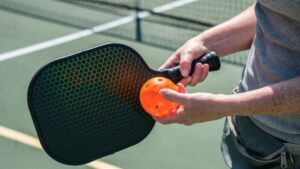
While a firm grip may seem advantageous in other sports, in pickleball, a soft touch is often the key to success, especially when it comes to blocking shots. Think of your paddle as an extension of your hand, and your grip as the conductor that orchestrates the perfect harmony between you and the ball.
Maintain a loose grip, with a pressure level around 4 out of 10. This gentle embrace allows for:
- Greater control
- More dexterity
- Ability to impart spin and pace
Instead of gripping tightly in your palm, let the paddle rest comfortably in your fingers, like a feather on a gentle breeze. This relaxed hold allows you to finesse shots with precision.
Ideal Blocking Grip:
- Pressure around 4/10
- Grip with fingers, not palm
- Loose, relaxed hold
Pro Tip: Imagine handling a delicate piece of china – too much force could shatter it. Approach your paddle with the same delicate touch to control and finesse even the most challenging shots with ease.
Technique 5: Mastering the No-Swing Block
Sometimes less is more in the world of pickleball blocking. Enter the no-swing block, a technique embracing simplicity and efficiency, like the ancient philosophy of wu wei – effortless action.
Instead of winding up for a powerful swing:
- Let the ball come to you
- Use your opponent’s pace to your advantage
By keeping your paddle in front and making minimal movement, you can redirect blistering shots back to your opponent’s court, leaving them scrambling.
The no-swing block’s beauty lies in controlling the game. By neutralizing aggressive shots and resetting rallies, you:
- Regain the upper hand
- Dictate the pace
It’s a defensive martial art – using your opponent’s force against them while maintaining composure, like a Zen master calmly deflecting blows.
Executing the No-Swing Block:
- Keep paddle in front of body
- Make minimal movement
- Let ball come to you
- Use opponent’s pace
Pro Tip: Imagine a matador sidestepping a raging bull, using its momentum to guide it. That’s the no-swing block essence – letting the ball’s energy work for you while staying in total control.
Additional Tips for Enhancing Blocking Skills
Mastering the core techniques is just the start. To truly excel at pickleball blocking, cultivate these skills and habits:
- Anticipation:
- Observe body language, paddle angles, shot patterns
- Gain clues about where the ball is headed
- Be better prepared to react and block effectively
- Practice, Practice, Practice:
- As with any skill, practice is key
- Dedicate time drilling blocking techniques
- Practice with variety of players and styles
Practice Drill Example:
- One player at non-volley line, hitting shots
- Partner blocks shots, focusing on stance, paddle positioning
Check out this video for more great drills:
- Embrace the Mindset:
- Blocking is mental as much as physical
- Cultivate a defensive mindset
- Be prepared to react and counter shots
- Approach rallies with a warrior’s focus
For mental toughness tips:
Conclusion
In the world of pickleball, blocking is more than just a defensive tactic – it’s an art form that requires finesse, strategy, and unwavering determination. By mastering the five essential techniques we’ve discussed, you’ll transform yourself from a mere spectator into a formidable force on the court, capable of deflecting even the most challenging shots with the grace of a matador and the poise of a seasoned warrior.
The journey to becoming a blocking maestro is not an easy one, but with dedication, practice, and a willingness to embrace the mindset, you’ll soon find yourself wielding your paddle like an extension of your own body, effortlessly neutralizing your opponent’s attacks and dictating the rhythm of the game.
Remember these key elements:
✔️ Low, athletic stance for mobility
✔️ Paddle positioned in front, elbow bent
✔️ Adjust paddle angle for incoming trajectory
✔️ Soft grip for touch and control
✔️ No-swing blocking to redirect opponent’s pace
Implement these techniques diligently, cultivate the supporting skills of anticipation and mental fortitude, and the pickleball court will become your canvas, where you paint masterpieces of defensive brilliance with every blocked shot.

